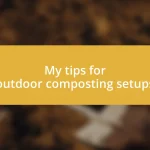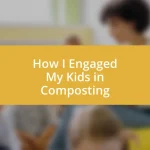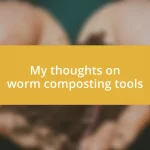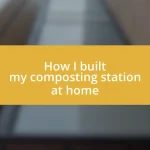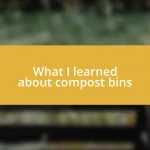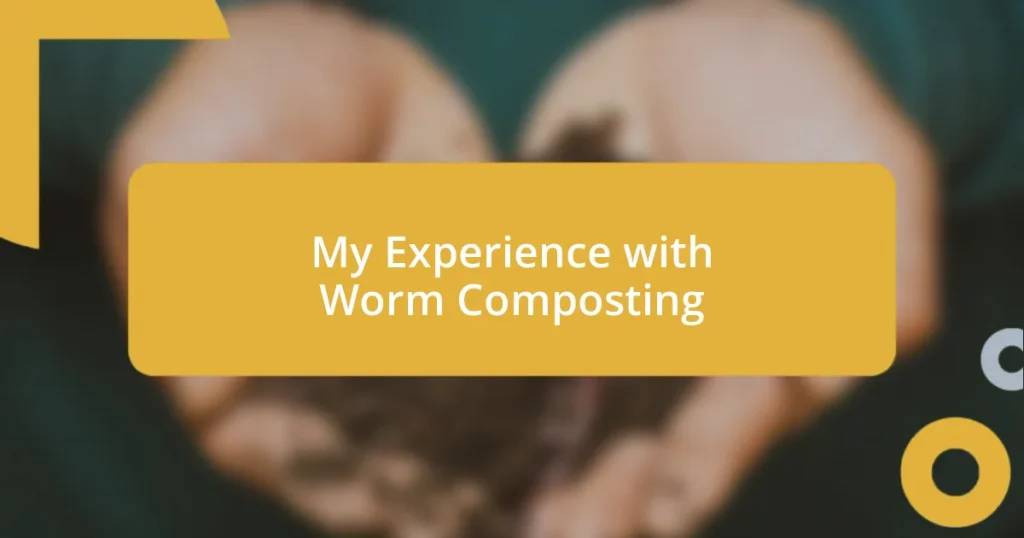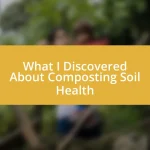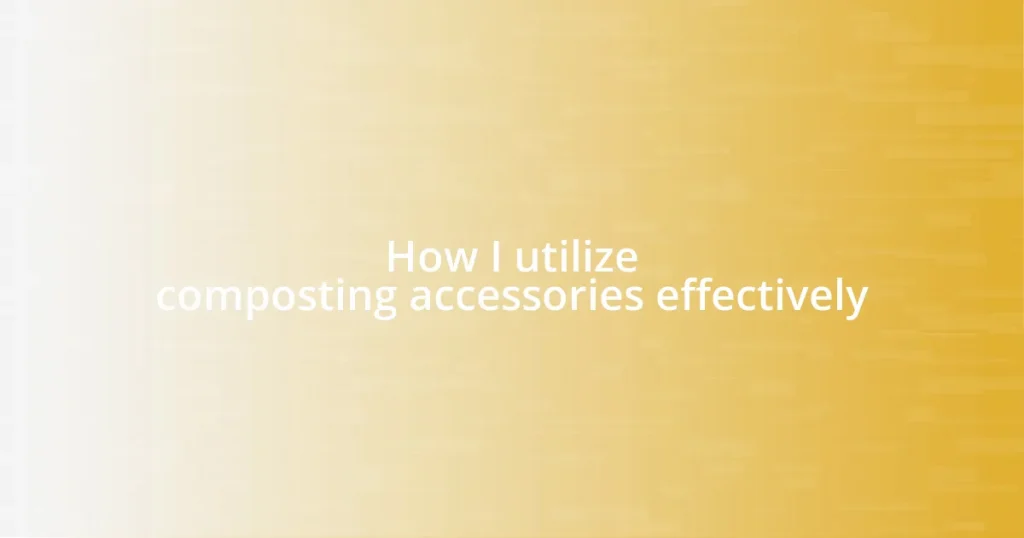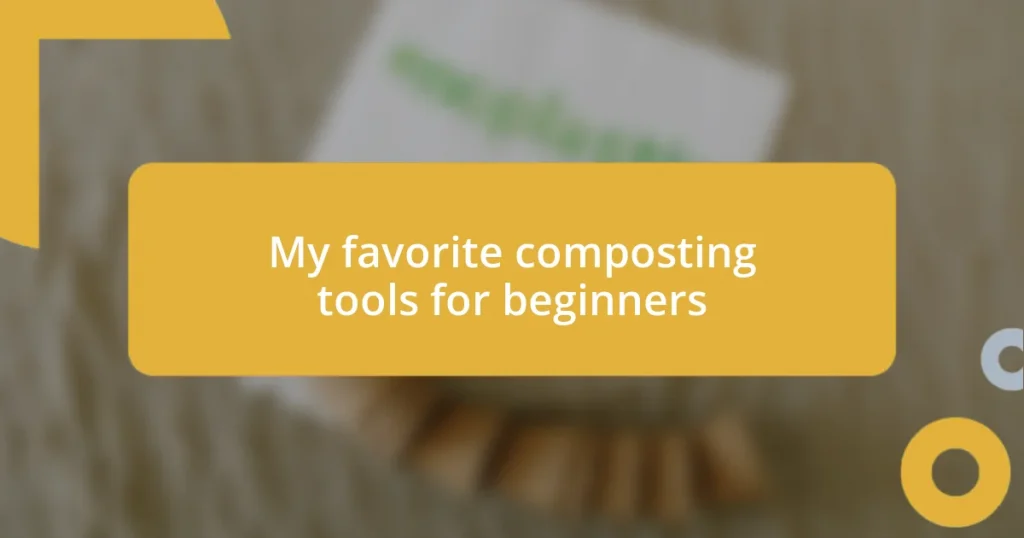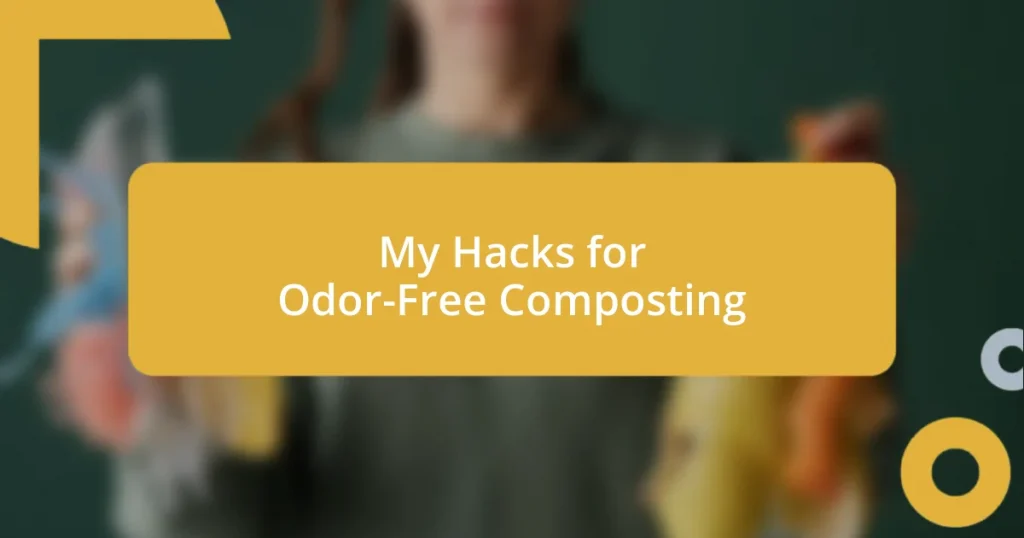Key takeaways:
- Worm composting, or vermicomposting, effectively transforms kitchen scraps into nutrient-rich compost through the help of red wigglers, improving waste management and enriching garden soil.
- Setting up a worm bin requires a simple setup of a container, bedding, moisture, and appropriate food scraps, providing a fulfilling way to engage with nature.
- Common issues in worm composting, such as acidity and pests, can be resolved through careful observation and adjustments, fostering a rewarding relationship with the ecosystem.

Understanding Worm Composting
Worm composting, often referred to as vermicomposting, is the process of using worms to break down organic waste into nutrient-rich compost. I remember the first time I set up my own worm bin; it felt like embarking on a tiny ecosystem adventure right in my kitchen. Have you ever thought about how something as small as a worm can play a significant role in transforming kitchen scraps into gold for your garden?
The magic happens mainly through red wigglers, the star performers in this process. When I opened my worm bin to see the rich, dark compost, I was enamored. It’s fascinating how these critters consume more than half their body weight in food each day, turning what would otherwise be trash into valuable nutrients for plants. How incredible is it that nature has its own recycling system right beneath our feet?
In my experience, setting up a worm composting system is both easy and rewarding. You simply need a bin, some bedding material, and, of course, the worms. Personally, I found joy in feeding them scraps and watching them thrive. Isn’t it heartwarming to know that by nurturing worms, you’re also nurturing the Earth?

Benefits of Worm Composting
When I first encountered worm composting, I was struck by its incredible efficiency. Leftover vegetable peels and coffee grounds that once cluttered my kitchen became food for my worms, turning into rich compost in no time. The transformation was remarkable, and it inspired me to realize how much waste we can actually divert from landfills.
One of the most rewarding aspects of worm composting is the positive impact it has on soil health. I noticed a significant difference in my garden’s vitality after using my homemade compost. The plants flourished, their colors deepened, and even my tomatoes tasted sweeter. It’s amazing to witness how feeding worms can lead to a bountiful harvest, enriching not just the plants but also my gardening experience.
Not only does worm composting reduce waste and create nutrient-dense soil, but it also fosters a sense of connection to nature that I truly cherish. I remember feeling a thrill when I first observed the interaction between the worms and the compost. It’s like a mini ecosystem that makes me feel a part of something larger. Could there be a more fulfilling hobby than nurturing life and contributing positively to the environment?
| Benefit | Description |
|---|---|
| Waste Reduction | Worm composting significantly reduces kitchen waste, diverting organic materials from landfills. |
| Soil Enrichment | Creates nutrient-rich compost that improves soil health and promotes plant growth. |
| Connection to Nature | Encourages a deeper appreciation for ecosystems, fostering a sense of environmental stewardship. |

Setting Up Your Worm Bin
Setting up your worm bin is a straightforward process that can be genuinely satisfying. I recall the excitement of gathering the materials for my first bin. I could feel the anticipation build as I prepared a cozy home for my little helpers. You don’t need much, just a few key components to get started.
Here’s what you’ll need:
- Container: A plastic or wooden bin, at least 10-18 gallons in size with a lid.
- Bedding: Shredded paper, cardboard, or coconut coir for the worms to burrow into.
- Moisture: Spray the bedding lightly with water to keep it damp, but not soaking.
- Worms: Red wigglers are the best choice for composting.
- Food scraps: Fruit and vegetable scraps work well; avoid dairy and meat.
As I combined these elements, I felt a sense of responsibility and joy. I remember the first time I added the worms and watched them wiggle into their new environment. It was like welcoming new pets into my home—one that would eventually give back more than I could imagine. The moment I saw the worms exploring their surroundings, I realized I was embarking on a journey toward sustainable living, and that made the effort worthwhile.

Choosing the Right Worms
Choosing the right worms is crucial for a successful composting experience. In my case, I went with red wigglers, also known as Eisenia fetida. They’re not just resilient; they thrive in a confined space and exponentially reproduce, giving you a robust composting system. Have you ever noticed how their wriggling behavior seems almost happy? Watching them work was like observing dedicated little workers in a bustling city.
I remember when I first considered alternatives, like nightcrawlers. While they’re great for fishing and larger gardens, I quickly learned they aren’t the best fit for indoor composting. They require more space and can be a bit sluggish in their composting abilities compared to red wigglers. This experience solidified my understanding of why it’s essential to choose wisely; the right worms make all the difference in how effectively you can manage your composting efforts.
Once you’ve selected red wigglers, consider where you’ll source them. I ordered mine from a reputable local supplier and felt a sense of excitement as they arrived in a small box. It was like receiving a tiny gift—one that would soon yield rich compost. The thrill of nurturing them and watching them transform my kitchen scraps into gold helped me grasp how significant my choice was; the right worms really kick-started my composting journey.

Maintaining Your Worm Bin
Maintaining your worm bin is a bit like nurturing a small garden. I learned that balancing moisture and airflow is essential. One day, after noticing a faint smell when I opened the lid, I realized I had overwatered the bedding. It was a quick fix—just adding dry newspaper helped absorb the excess. Have you ever had a moment where small adjustments made all the difference? I certainly have!
Feeding your worms is crucial—it’s not just about quantity but quality too. Initially, I was a bit careless with what I tossed in, but over time I recognized the importance of cutting up scraps into smaller pieces. I remember the first time I saw them happily munching through finely chopped cucumber peels. It felt rewarding, like I was sharing lunch with my little compost companions. Regular feedings ensure they’re healthy, and you’ll definitely want to avoid anything too acidic, like citrus, which can upset their delicate balance.
Lastly, keep an eye on the temperature and the overall condition of the bin. I once let my bin sit in a sunny spot, and the heat caused some worms to escape. It was quite a sight! Since then, I’ve always placed my bin in a cooler, shaded area. It’s fascinating how attentive I’ve had to become—these little creatures thrive when I pay attention to their needs. Have you noticed how small changes in environment can lead to big results? That’s exactly what I experienced with my worm bin!

Using the Finished Compost
Using the finished compost is like uncovering a hidden treasure. The first time I sifted through my completed worm castings, I was amazed at the rich, dark texture. It felt like gold in my hands—everything I had nurtured and fed had transformed into this remarkable nutrient-rich compost. I’ve often wondered how a simple kitchen scrap could turn into such a powerful soil amendment. It just shows how nature works its magic if we give it the right conditions.
I remember being cautious about how much compost to apply to my plants. Initially, I overestimated; I thought more would definitely be better. But after observing my plants for a few weeks, I realized they were struggling with the excess. It was a learning curve—now, I usually mix it into the soil or add it to the top layer, letting my plants soak up the nutrients gradually. How did I arrive at this balance? It was all about experimentation and observing the results closely, which made the process even more enriching.
One of my favorite uses for the finished compost has been in my herb garden. I will never forget the moment I sprinkled a generous layer around my basil plants. It felt like giving them a cozy blanket of nutrition. A few weeks later, they exploded with growth! It’s almost like they were thanking me for the little boost. Have you ever noticed how plants thrive when they receive the right care? That experience taught me the profound connection between nurturing soil health and witnessing vibrant plant life.

Troubleshooting Common Issues
Troubleshooting in worm composting can feel daunting at times, but I’ve learned through my experiences that most issues are fixable. For instance, when I noticed my worms clustering at the top of the bin, I realized they were escaping the increasingly acidic environment caused by too many citrus scraps. A simple tweak—reducing acidic feedings and adding a handful of crushed eggshells for balance—quickly turned things around. It’s amazing how a little observation can lead to big solutions, isn’t it?
Another common hiccup is the presence of fruit flies, which can be quite a nuisance. The first time I dealt with them, I felt overwhelmed. However, I found that covering the food scraps with a layer of finished compost not only deterred these pests but also provided a cozy blanket for my worms to thrive beneath. Have you ever noticed how just a simple change in approach can significantly improve a situation? I definitely have!
Lastly, if your worms are sluggish or not eating, it may be time to assess the moisture level again. I recall a point when I thought I was being conservative with watering, but I ended up depriving my worms of that essential moisture. Once I misted the bin lightly and restored the humidity, I could practically watch them perk up and get back to work! Monitoring the condition of your bin is key; it becomes a delightful partnership between you and these incredible little creatures.



